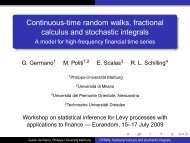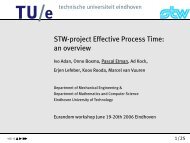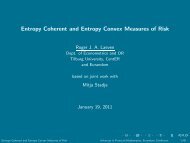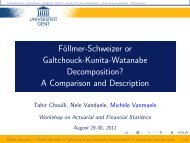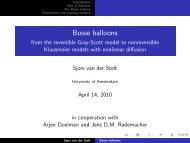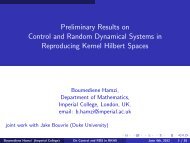Formal asymptotics for blowup in the Willmore flow - Eurandom
Formal asymptotics for blowup in the Willmore flow - Eurandom
Formal asymptotics for blowup in the Willmore flow - Eurandom
Create successful ePaper yourself
Turn your PDF publications into a flip-book with our unique Google optimized e-Paper software.
<strong>Formal</strong> <strong>asymptotics</strong> <strong>for</strong> <strong>blowup</strong> <strong>in</strong> <strong>the</strong> <strong>Willmore</strong><br />
<strong>flow</strong><br />
Michelangelo Vargas and Jan Bouwe van den Berg<br />
April 15, 2010
Introduction<br />
Consider an elastic surface. The elastic energy of <strong>the</strong> surface is<br />
given by<br />
<br />
E = (α + βH 2 + γK)dµ,<br />
where <strong>the</strong> <strong>in</strong>tegral is over <strong>the</strong> surface Ω and<br />
◮ H is <strong>the</strong> mean curvature,<br />
◮ K is <strong>the</strong> Gaussian curvature.<br />
Ω
Introduction<br />
Consider an elastic surface. The elastic energy of <strong>the</strong> surface is<br />
given by<br />
<br />
E = (α + βH 2 + γK)dµ,<br />
where <strong>the</strong> <strong>in</strong>tegral is over <strong>the</strong> surface Ω and<br />
◮ H is <strong>the</strong> mean curvature,<br />
◮ K is <strong>the</strong> Gaussian curvature.<br />
The first term represents surface tension, while<br />
<strong>the</strong> second and third term model <strong>the</strong> bend<strong>in</strong>g<br />
energy. The equilibrium shape of certa<strong>in</strong> cells<br />
can be found by m<strong>in</strong>imis<strong>in</strong>g <strong>the</strong> bend<strong>in</strong>g energy.<br />
For example <strong>the</strong> red blood cell.<br />
Ω
Introduction<br />
Consider an elastic surface. The elastic energy of <strong>the</strong> surface is<br />
given by<br />
<br />
E = (α + βH 2 + γK)dµ,<br />
where <strong>the</strong> <strong>in</strong>tegral is over <strong>the</strong> surface Ω and<br />
◮ H is <strong>the</strong> mean curvature,<br />
◮ K is <strong>the</strong> Gaussian curvature.<br />
The first term represents surface tension, while<br />
<strong>the</strong> second and third term model <strong>the</strong> bend<strong>in</strong>g<br />
energy. The equilibrium shape of certa<strong>in</strong> cells<br />
can be found by m<strong>in</strong>imis<strong>in</strong>g <strong>the</strong> bend<strong>in</strong>g energy.<br />
For example <strong>the</strong> red blood cell.<br />
Ω
The <strong>Willmore</strong> <strong>flow</strong> I<br />
S<strong>in</strong>ce <strong>the</strong> <strong>in</strong>tegral over <strong>the</strong> Gaussian curvature is a constant<br />
(Gauss-Bonnet), m<strong>in</strong>imis<strong>in</strong>g <strong>the</strong> bend<strong>in</strong>g energy comes down to<br />
m<strong>in</strong>imis<strong>in</strong>g <strong>the</strong> <strong>Willmore</strong> functional<br />
<br />
H 2 dµ.<br />
Ω<br />
M<strong>in</strong>imis<strong>in</strong>g this <strong>in</strong>tegral gives <strong>the</strong> so-called <strong>Willmore</strong> <strong>flow</strong>. This is a<br />
partial differential equation on a surface.
Surface evolution<br />
Consider a mov<strong>in</strong>g surface φ(t) : M → R 3 parametrised by t, with<br />
metric gij = 〈∂iφ, ∂jφ〉.<br />
¯φt(p, t)<br />
p<br />
q<br />
¯φt(q, t)<br />
Here, ¯ φt is <strong>the</strong> displacement of <strong>the</strong> surface <strong>in</strong> <strong>the</strong> normal direction.
The <strong>Willmore</strong> <strong>flow</strong> II<br />
The <strong>Willmore</strong> <strong>flow</strong> is given by<br />
with<br />
◮ H : mean curvature,<br />
◮ K : Gaussian curvature,<br />
¯φt = −∆H − 2H(H 2 − K),<br />
◮ ∆ : Laplace-Beltrami operator. Generalisation of Laplacian<br />
given by<br />
1<br />
<br />
∆ = √ ∂i g<br />
det g ij <br />
det g∂j .
Curvatures<br />
Let κ1 and κ2 be <strong>the</strong> maximal and m<strong>in</strong>imal curvatures of a surface<br />
at a particular po<strong>in</strong>t. The mean and Gaussian curvatures at that<br />
po<strong>in</strong>t are given by<br />
H = 1<br />
2 (κ1 + κ2),<br />
K = κ1κ2.<br />
<strong>Willmore</strong> <strong>flow</strong> : ¯φt = −∆H − 2H(H 2 − K).
The sphere<br />
Consider a sphere of radius R. If we choose <strong>the</strong> normal such that it<br />
po<strong>in</strong>ts outwards, <strong>the</strong>n<br />
everywhere. Hence,<br />
H = − 1<br />
R<br />
on <strong>the</strong> whole sphere.<br />
We see immediately that<br />
κ1 = κ2 = − 1<br />
R ,<br />
1<br />
and K = ,<br />
R2 ¯φt = −∆H − 2H(H 2 − K) = 0.
The sphere and more<br />
◮ The <strong>Willmore</strong> energy <strong>for</strong> a sphere is 4π.<br />
◮ The <strong>Willmore</strong> energy is scale <strong>in</strong>variant.<br />
◮ The sphere is a global m<strong>in</strong>imum <strong>for</strong> closed immersed surfaces.
The sphere and more<br />
◮ The <strong>Willmore</strong> energy <strong>for</strong> a sphere is 4π.<br />
◮ The <strong>Willmore</strong> energy is scale <strong>in</strong>variant.<br />
◮ The sphere is a global m<strong>in</strong>imum <strong>for</strong> closed immersed surfaces.<br />
A surface with κ1 = −κ2, everywhere, is also a stationary solution<br />
(H = 0). This surface is given by <strong>the</strong> graph<br />
<br />
z<br />
<br />
r(z) = q cosh ,<br />
q<br />
rotated around <strong>the</strong> z-axis.
Properties of <strong>Willmore</strong> <strong>flow</strong><br />
◮ The <strong>Willmore</strong> <strong>flow</strong> is a fourth order, nonl<strong>in</strong>ear, differential<br />
equation.<br />
◮ Short time existence (parabolic quasi l<strong>in</strong>ear)<br />
◮ Long time existence<br />
◮ <strong>for</strong> solutions close to a local m<strong>in</strong>imum<br />
◮ <strong>for</strong> immersed spheres with <strong>Willmore</strong> energy lower equal to 8π<br />
◮ two-dimensional graphs<br />
◮ If <strong>blowup</strong> occurs, <strong>the</strong> <strong>blowup</strong> profile must be stationary.
Problem<br />
Can <strong>the</strong> <strong>Willmore</strong> <strong>flow</strong> create a s<strong>in</strong>gularity on a smooth surface <strong>in</strong><br />
f<strong>in</strong>ite time?
Problem<br />
Can <strong>the</strong> <strong>Willmore</strong> <strong>flow</strong> create a s<strong>in</strong>gularity on a smooth surface <strong>in</strong><br />
f<strong>in</strong>ite time?<br />
Numerical computations suggest that this can happen. Consider<br />
<strong>the</strong> follow<strong>in</strong>g curve (a so-called Limaçon) rotated around <strong>the</strong><br />
horizontal axes.
Numerical computations<br />
Numerical computations suggest that a Limaçon, governed by <strong>the</strong><br />
<strong>Willmore</strong> <strong>flow</strong>, creates a s<strong>in</strong>gularity <strong>in</strong> f<strong>in</strong>ite time.<br />
Note<br />
◮ a self <strong>in</strong>tersection is not a s<strong>in</strong>gularity<br />
◮ <strong>the</strong> tip drops with a quasi stationary rate<br />
◮ <strong>the</strong> different scales<br />
Goal of our research is to determ<strong>in</strong>e <strong>the</strong> rate with which <strong>the</strong> tip<br />
drops. Call this rate λ.
Different scales<br />
There are three regions <strong>in</strong> this problem correspond<strong>in</strong>g to three<br />
different scales.<br />
◮ In <strong>the</strong> remote region <strong>the</strong> solution hardly moves.<br />
◮ In <strong>the</strong> outer region <strong>the</strong> solution evolves (by def<strong>in</strong>ition) with<br />
<strong>the</strong> self similar scale (T − t) 1/4 .<br />
◮ In <strong>the</strong> <strong>in</strong>ner region <strong>the</strong> solution is governed by <strong>the</strong> <strong>blowup</strong> rate.<br />
Remote Region<br />
r(s)<br />
0.8<br />
0.6<br />
0.4<br />
0.2<br />
Outer Region<br />
Inner Region<br />
–1 –0.5 0<br />
0.5 1<br />
z(s)
Matched <strong>asymptotics</strong><br />
On every region we can simplify <strong>the</strong> equation differently.<br />
◮ In <strong>the</strong> remote region one can use κ1 ∼ κ2.<br />
◮ In <strong>the</strong> outer region we use zr → 0.<br />
◮ In <strong>the</strong> <strong>in</strong>ner region we can use κ1 ∼ −κ2.<br />
Match<strong>in</strong>g means that <strong>the</strong> solutions should behave <strong>the</strong> same <strong>in</strong> <strong>the</strong><br />
<strong>in</strong>termediate regions.
Results<br />
◮ Match<strong>in</strong>g gives<br />
(T − t)1/2<br />
λ ∼ <br />
1 | ln | 4<br />
.<br />
T −t
Results<br />
◮ Match<strong>in</strong>g gives<br />
(T − t)1/2<br />
λ ∼ <br />
1 | ln | 4<br />
.<br />
T −t<br />
◮ But we do not f<strong>in</strong>d a Limaçon that becomes s<strong>in</strong>gular.<br />
◮ We f<strong>in</strong>d a dumbbell.
Future work<br />
◮ Study <strong>the</strong> dumbbell more carefully.<br />
Numerically and analytically.<br />
◮ Use o<strong>the</strong>r match<strong>in</strong>g to describe <strong>the</strong> <strong>blowup</strong> of <strong>the</strong> Limaçon.<br />
Use mov<strong>in</strong>g mesh methods to study <strong>the</strong> evolution.


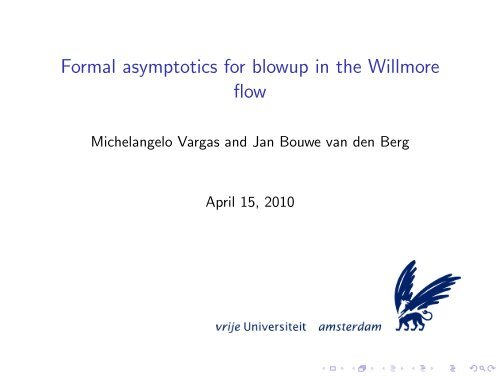
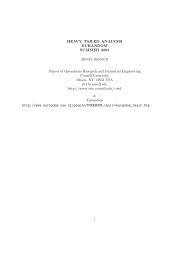
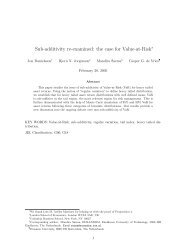
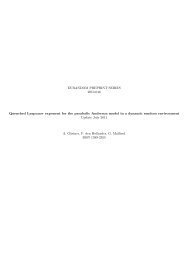
![The Contraction Method on C([0,1]) and Donsker's ... - Eurandom](https://img.yumpu.com/19554492/1/190x143/the-contraction-method-on-c01-and-donskers-eurandom.jpg?quality=85)

